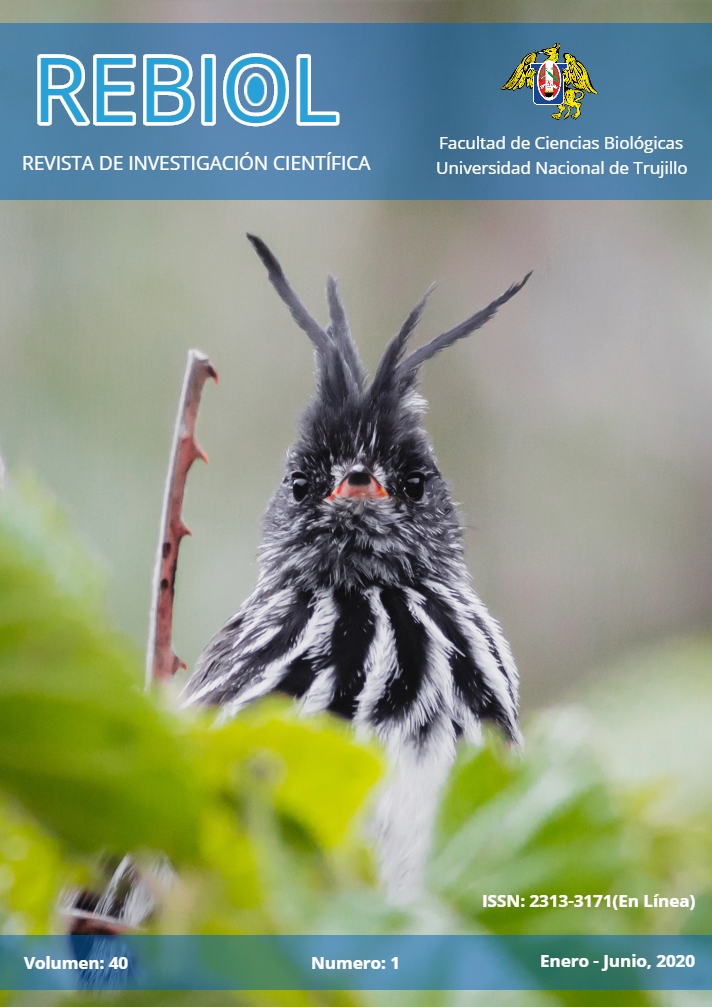MORPHOMETRIC DISTINCTION OF DOMESTIC AND SYLVATIC POPULATIONS OF Rhodnius ecuadoriensis FROM DIFFERENT GEOGRAPHICAL ORIGINS
Resumen
ABSTRACT
Rhodnius ecuadoriensis (Hemiptera, Reduviidae) is an important vector of both Trypanosoma hemoflagellates, Trypanosoma cruzi and Trypanosoma rangeli, in Ecuador and Peru. Ecotopes of sylvatic and domestic/peridomestic habitats have been reported in Ecuador. Meanwhile in Peru, to the best of our knowledge, findings of sylvatic populations in their different ecosystem regions have not yet been documented. Could this be the product of a lack of appropriate studies on wild populations of triatominae in Peruvian environments? In order to elucidate this topic, we take advantage of new insights in geometric morphometry as a tool to help differentiate between wild populations and the corresponding domestic/peridomestic ones, collected in their respective environments. When analyzing our results, we confirmed the efficacy of this technique in our study, and furthermore, we believe that it could be a proper tool for rangeliosis and Chagas disease vector control surveillance in Ecuador and Peru.
Keywords: Morphometric geometry, sylvatic, domestic/peridomiestic populations distinction, Rhodnius ecuadoriensis.
RESUMEN
Rhodnius ecuadoriensis (Hemiptera, Reduviidae) es un importante vector de los tripanosomas Trypanosoma cruzi y Trypanosoma rangeli en el Ecuador y Perú. Se han reportado ecotopos de hábitats silvestres y domésticos/peridomésticos en Ecuador. Sin embargo, en Perú, hasta donde sabemos, no se ha documentado hallazgos de dichas poblaciones silvestres. ¿Podría este ser el caso de una falta de estudios focalizados en la búsqueda de poblaciones silvestres de triatominos dentro de los diferentes ecosistemas del Perú? Para elucidar este tema, aplicamos nuevas perspectivas en morfometría geométrica, como una herramienta que podría auxiliar en la diferenciación de poblaciones silvestres de aquellas domésticas/peridomésticas, colectadas en sus respectivos ambientes naturales. Al analizar nuestros resultados, se confirmó la utilidad de esta técnica dentro de nuestro estudio, y esto nos llevó a creer asimismo que serviría como un elemento apropiado en el control vectorial de la enfermedad de Chagas y de la rangeliosis, en Ecuador y Perú.
Palabras claves: Geometría morfométrica, silvestre, diferenciación de poblaciones domesticas/peridomesticas, Rhodnius ecuadoriensis.
Citas
Abad-Franch, F. 2000. Ecology and genetics of Chagas disease vectors in Ecuador. Implications for the design of control strategies. MPhil-Phd Upgrading Report. London School of Hygiene and Tropical Medicine. University of London, UK. 150 pp.
Abad-Franch, F., Paucar, C., Carpio, C., Cuba Cuba C., Aguilar, V. y Miles, M. 2001. Biogeography of Triatominae (Hemiptera: Reduviidae) in Ecuador: Implications for the design of control strategies. Memorias do Instituto Oswaldo Cruz, 96. 611-620.
Cuba Cuba CA., Abad-Franch, F., Roldan, J., Vargas, F., Pollack, L. y Miles, M. 2002. The Triatomines of Northern Peru, with emphasis on the Ecology and infection by Trypanosomes of Rhodnius ecuadoriensis (Triatominae). Memorias do Instituto Oswaldo Cruz 97, 175-183.
Cuba Cuba C., Vargas, F., Roldan, J. y Ampuero, C. 2003. Domestic Rhodnius ecuadoriensis (Hemiptera: Reduviidae) infestation in Northern Peru A comparative trial of detections methods during a six-month follow-up. Revista do Instituto de Medicina Tropical de São Paulo. São Paulo 45 (85-9092).
Dujardin, J., Bermudez, H., Casini, C., Schofield, C. y Tibayrenc, M. 1997. Metric differences between sylvatic and domestic Triatoma infestans (Hemiptera: Reduviidae) in Bolivia. Journal of Medical Entomology.34, 544-551.
Guhl, F., Pinto, N. y Aguilera, G. 2009. Sylvatic triatominae a new challenge in vector control transmission. Memorias do Instituto Oswaldo Cruz 104 (Suppl. 1): 71-75.
Jaramillo, N. 2000. Partición en tamaño y forma de los caracteres métricos y su interés en los estudios poblacionales aplicados a los Triatominos. PhD Thesis, University of Antioquia, Medellin, Colombia, 125 pp.
Lent, H. y León, L. 1958. Um novo Rhodnius Stäl do Ecuador (Hemiptera, Reduviidae). Rev Brasil Biol 18: 181-185.
Lent, H. y Wygodzinsky, P. 1979. Revision of the Triatominae (Hemiptera: Reduviidae), and their significance as vectors of Chagas disease. Bulletin of the American Museum of Natural History, 163(3), 123-520.
Patterson, J., Abad-Franch, F., Aguilar, V., Cuba Cuba, C. y Miles, M. 2002. Morphometrics of Rhodnius ecuadoriensis (Triatominae) populations: a tool for Chagas disease vector control surveillance in Ecuador and Perú. Transactions of the Royal Society of Tropical Medicine and Hygiene. 96 (4)353-464.
Schofield, C. 2001. Field testing and evaluation of insecticides for indoor spraying against domestic vectors of Chagas disease. WHO/CDC/WHOPES/GCDPP/2001. 1WHO, Geneva, Switzerland, 53 pp.
Publicado
Cómo citar
Número
Sección
Licencia
Derechos de autor 2020 J S. Patterson, F. Abad - Franch, C A Cuba, M A Miles

Esta obra está bajo una licencia internacional Creative Commons Atribución-NoComercial-CompartirIgual 4.0.
Política propuesta para revistas que ofrecen acceso abierto
- Los autores/as conservarán sus derechos de autor y garantizarán a la revista el derecho de primera publicación de su obra, el cual estará simultáneamente sujeto a la «Licencia de reconocimiento» de Creative Commons que permite a terceros compartir la obra siempre que se indique su autor y su primera publicación en esta revista.
- Los autores podrán adoptar otros acuerdos de licencia no exclusiva de distribución de la versión de la obra publicada (por ejemplo, depositarla en un repositorio institucional o publicarla en un libro) siempre que se indique la publicación inicial en esta revista.
- Los autores tienen el derecho a hacer una posterior publicación de su trabajo, de utilizar el artículo o cualquier parte de aquel (por ejemplo: una compilación de sus trabajos, notas para conferencias, tesis, o para un libro), siempre que indiquen su publicación inicial en la revista REBIOL (autores del trabajo, revista, volumen, número y fecha).







